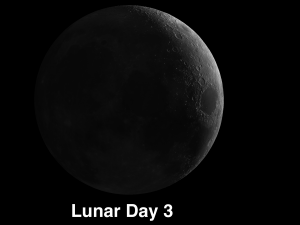The week of October 31 – November 6 takes us from Lunar Day 1 to half way through Day 6. The Moon won’t be high enough off the horizon and out of atmospheric murk until Thursday evening when it’s almost four days old. Nevertheless, let’s try for an interesting feature on Wednesday night. This week we will highlight Dorsum Oppel, a wrinkle ridge on Mare Crisium. 
Dorsum Oppel: [NE/H15] As the lava cooled following the impact that created Mare Crisium, a series of wrinkle ridges, known as Dorsum Oppel, formed along the entire western edge and give the impression of waves lapping on the shore. The flowing lava partially filled the pre-existing craters Yerkes and Lick [H15], turning them into ghost craters.
 There is also a more substantial ridge that connects the flooded crater Yerkes with the smaller Yerkes E, 15 miles to its northwest (unnamed on the Field Map). Under a low Sun, when the terminator is around 52°-55°E, this ridge will combine with the SW rim of Yerkes to look remarkably like the silhouette of a bird in flight. It has consequently been nicknamed the Flying Eagle. (This feature may be seen to better advantage on Day 17 when the Sun is setting.)
There is also a more substantial ridge that connects the flooded crater Yerkes with the smaller Yerkes E, 15 miles to its northwest (unnamed on the Field Map). Under a low Sun, when the terminator is around 52°-55°E, this ridge will combine with the SW rim of Yerkes to look remarkably like the silhouette of a bird in flight. It has consequently been nicknamed the Flying Eagle. (This feature may be seen to better advantage on Day 17 when the Sun is setting.)
OF ADDITIONAL INTEREST THE WEEK OF OCTOBER 31 – NOVEMBER 6:
 In the evening twilight watch Venus as it rapidly wends its way eastward. Last Thursday Venus formed a straight line between Saturn and Antares. On Wednesday they will form a right triangle, with the Moon immediately above Saturn. The combination of the Moon, Venus, and Saturn should be a lovely naked-eye sight low on the horizon in deep twilight. Look for earthshine (also known as the old Moon in the New Moon’s arms). The Earth will be reflecting sunlight from its daytime portion onto the Moon’s dark side, which is then reflected back to us. Using binoculars you should be able to spot the crater Aristarchus, even though it’s on the dark side, because it is the brightest spot on the Moon. It is so bright that Sir William Herschel1 mistook it for an erupting volcano.
In the evening twilight watch Venus as it rapidly wends its way eastward. Last Thursday Venus formed a straight line between Saturn and Antares. On Wednesday they will form a right triangle, with the Moon immediately above Saturn. The combination of the Moon, Venus, and Saturn should be a lovely naked-eye sight low on the horizon in deep twilight. Look for earthshine (also known as the old Moon in the New Moon’s arms). The Earth will be reflecting sunlight from its daytime portion onto the Moon’s dark side, which is then reflected back to us. Using binoculars you should be able to spot the crater Aristarchus, even though it’s on the dark side, because it is the brightest spot on the Moon. It is so bright that Sir William Herschel1 mistook it for an erupting volcano.
1 18th c. English astronomer who discovered Uranus.
======================
It is highly recommended that you get a copy of Sky and Telescope’s Field Map of the Moon, the very finest Moon map available for use at the telescope. It is available for $10.95 at www.skyandtelescope.com and on Amazon. All features mentioned in this blog will be keyed to the grid on the Field Map and will look like this: Plato: [NW/D9]
Credits:
Courtesy of Gray Photography of Corpus Christi, Texas
Lunar photos: NASA / USGS / BMDO / LROC / ASU / DLR / LOLA / Moon Globe. Used by permission
- Rupes Cauchy: A Best Known Fault on the Moon - July 22, 2024
- Moon Crater Schickard – Crater Floor has Stripes - July 15, 2024
- Moon Craters Langrenus and Vandelinus - July 8, 2024